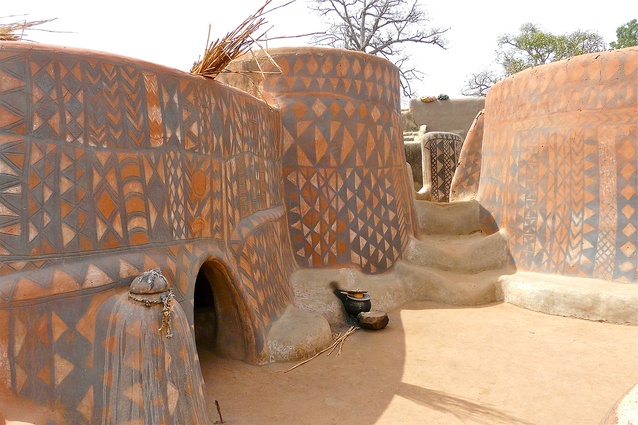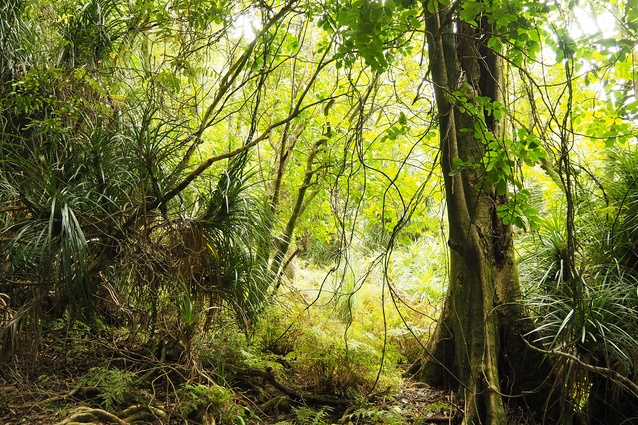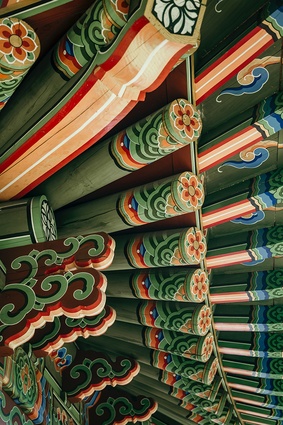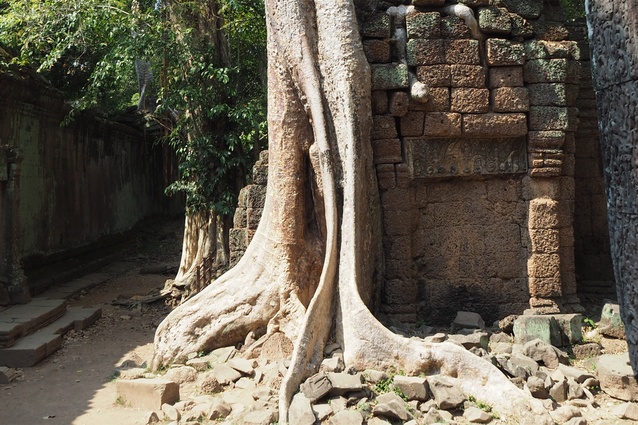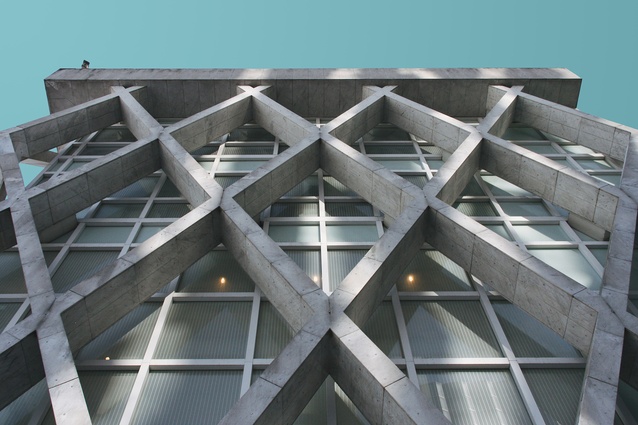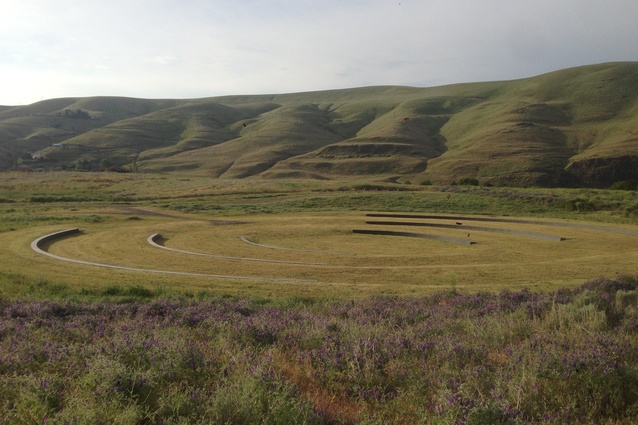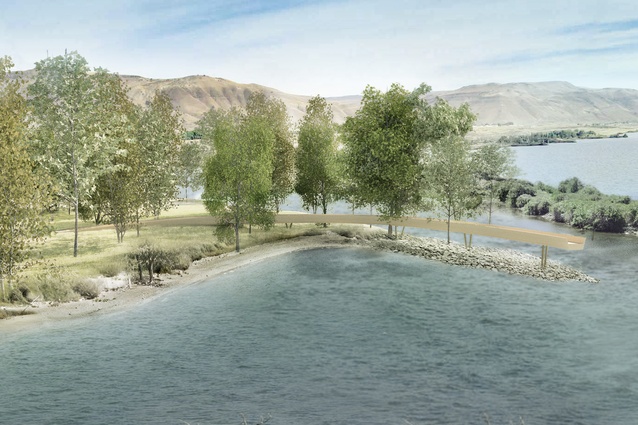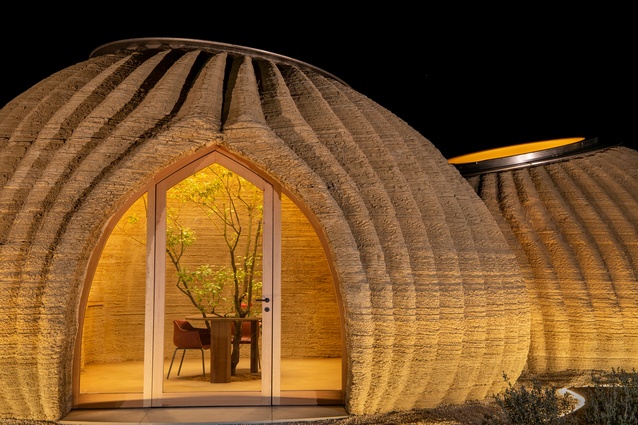Think like a tree
Designer and environmentalist David Trubridge believes modernist architecture is perpetuating a form of patriarchal and capitalist control inherited from our coloniser past, and explains why we must decolonise our minds and find inspiration from nature in order to save it — by thinking like a tree...
I have been giving talks about environmental issues for over 20 years. For a long time, the greatest need was to persuade people that there was a problem. Now, in 2022, there is no doubt. We know there is a very serious problem. But, to understand how we must respond, we need to dig a little deeper. I’ll get to the tree in a while…
We know we are in the midst of a climate crisis — but what caused that and what has made us live in denial for so long? I really believe that the fundamental problem with the developed world is our state of mind. We have been brought up to think that humans are special and above nature — that nature is there for our benefit, to use and exploit for our own gain — and that we can design ourselves out of danger, like we have always done.

Many of the answers as to why we find ourselves in this predicament lie in our coloniser past. Our mindscape has, in effect, been “colonised” by a certain way of thinking that grew out of a very different, imperial world. It is not natural or innate for the human race to place itself in a superior position over the rest of the natural world, and today we only see this in developed nations. There are many native societies that have retained a very different worldview. Colonisation is not just empire builders strutting around in pith helmets bringing civilisation to heathens. It is a very pernicious state of mind that exists today in a less overt form. This state of mind emanated out of Europe and Britain initially, then, more recently, from the USA.
Colonisation over-ran the vibrant mix of local cultures which, in response to varying local conditions, had grown up around the world. Spearheaded by missionaries, it did everything it could to eradicate local differences. A language that had evolved as the expression of a land and its people was forbidden to be spoken. So, the voice of the land died and, with it, untold knowledge. Also forbidden were local religions and customs. Children were forcibly separated from families to be brought up in the colonial way. Common land was divided up into title blocks, fenced and sold to settlers; essentially, colonialism is a form of control.
All this because the perpetrators were suffused with the unquestioning belief that their way was superior, that they were doing a favour to the poor and simple natives, while actually lining their own pockets. Also implicit in colonisation are racism and patriarchy — the rule of the privileged white male.

In the business world, colonialism is represented by the multi-national corporation. Its product is utterly bland and homogenous; it not only takes no heed of any localness but, again, intentionally eradicates it. Think Exxon, MacDonalds, KPMG, Prada, and all the fashion stores that have taken over every expensive shopping centre. In other words, today’s result of colonisation is the global imposition of capitalism.
I cannot deny that this system has brought a lot of prosperity to some, though by no means all. If it hadn’t been for the climate crisis, it could probably have muddled on. But, the crisis has exposed the innate weakness of capitalism, which has shown itself to be totally unable to respond to the challenge of our times. It has stubbornly dug in its heels and resisted every attempt at change, at every step of the way, thus abdicating any relevance to future planning. It is then patently obvious that to create a new hopeful future, we must get rid of colonialism (the state of mind) and capitalism (colonialism’s contemporary manifestation).
So what is the opposite of colonialism? Indigenisation
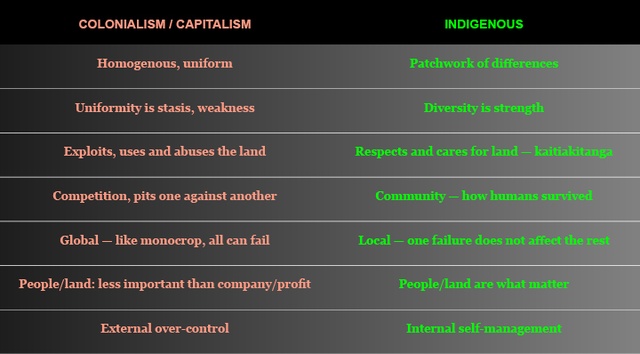
Where the colonial abuses the land, the indigenous respects and cares for it, knowing that the two are inter-dependent — to abuse the land, is ultimately to abuse yourself. Colonial individuals compete against each other — indigenous peoples form communities. In times of survival, individuals are weak. Homo sapiens survived through early ice ages by coming together in resilient, self-supporting communities. I believe that we must indigenise. Where the colonial is homogenous, the indigenous is a myriad patchwork of differences. In nature, diversity is strength, whereas uniformity (i.e. lack of diversity as seen in monocrops), results in stasis and, ultimately, decay as disease sets in.
Moreover, the colonial system is global, meaning if the system fails, the whole world fails. Indigenous, however, is local — if one community fails, it does not need to affect the next one. Colonialism is outside control — indigenous is the community controlling itself and so on…

So how does this relate to architecture? What is the expression of colonialism in built form? I give you modernism. Modernism most likely began in a small German town called Weimar. It was primarily an attempt by the architect Walter Gropius to synthesise all the arts — to homogenise. From that beginning there developed the bland, formal (i.e. primacy of form), sometimes brutal style of architecture that persists today.
I would suggest that this style is the design equivalent of colonialism. It even has a whiff of racial purity about it. Modernism swept through the world, imposing its rigid ideals of purity over “gratuitous decoration”. To a modernist, decoration, pattern-making, vivid colours and natural materials are all the lesser — and, dare I say it, more feminine — traits of indigenous design, which are seen as inferior, impure and quaint — not real design.

It follows, then, that Western design as we know it today is just another form of colonial imposition. The architect/designer acts as a god-like figure dropping his (and it is usually his) egotistical creations into place, with little or no care for the land, users or culture. Modernism is another mindset. And, like any mindset, it can seem like the norm until you stand back objectively and see it for what it is. At any normal time, we could settle into reasoned debate, and accept our differences. But the situation today is not normal, we are in crisis. And if the mindset is part of the cause of the crisis, then it has to change. If we are to do that, to overcome colonialism (which I believe we have to do, to combat our dreadful effect on the environment), one way is to embrace the indigenous way of thinking and designing.

What is indigenous design? We actually have our own term for it: Biophilic design (potentially another manifestation of colonial appropriation — of giving something already there a new name). So, what is biophilic design? The name stems from ancient Greek ‘bio’ (life) and ‘philia’ (love) and is based on the presumption that a mutually beneficial biosis exists between man and nature — the benefit of which can be had through designing the way nature does. Biophilic design (BD) is not just planting green walls and trees in pots in our buildings, however much we might need them. It is so much more: it is replicating the processes of nature — in other words, thinking like a tree.
BD is bottom-up enabling, working with the land and all its communities, both human and fauna/flora/geological. It takes what is already there and gently moulds that into an almost inevitable result — but not wholly inevitable because there is also an artistic input. The result grows from within, without any outside control and imposition from a designer.
Now, if Western culture has appropriated the word design to describe its top-down colonialist process (a manifestation of the colonial mindset), then surely the term ‘biophilic design’ is an oxymoron? If it is biophilic (i.e. enabling from bottom up), it can’t also be design (i.e. imposition from top down). What can we call it?

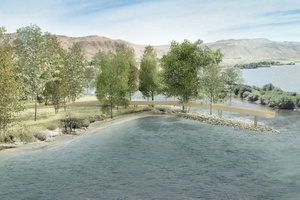
While you think about that, I want to give you my favourite example of ego-less biophilic design. In Portland, Oregon, I went to a talk by the Asian American artist Maya Lin. She had been asked to design improvements to a park at the mouth of the Columbia River, a site of spiritual significance to local indigenous peoples that also contains early settler history. She said that her guiding principle for the project was “to make it look like I had not been there”.
That is one of the most inspiring statements I have heard from a designer. And is it a coincidence that it was spoken by a woman, and one of mixed race? Is it not likely that a white male artist would have imposed onto the land a phallic monument or a brutal CorTen steel or concrete box?
Maya Lin took what was already there and did no more than gently mould it into a cohesive life of its own. Visitors can make their own discoveries of history from the small clues she has left.
But biophilic design is not just about process; it is also about what materials we choose to work with. If a material or process is harmful or wasteful to the community, then it has no place in biophilic design.
We know that concrete — the material fetishised by modernists — is the “most destructive material on earth” (the Guardian). Proponents say that it lasts so long that, when its large initial carbon emissions are amortised over its lifetime, the yearly emissions are very small. But we no longer have time for that: today it is only the upfront carbon emissions that matter.
So, we must build with materials that have the lowest embedded carbon, even if their lifespan is less and maintenance is greater: timber, mud, straw, etc. All of which are locally sourced — and which require local craftspeople trained in their use. This will inevitably give the designs a local flavour, like all the indigenous crafts around the world. It will speak the language of place and people. But I am not advocating a return to an idealised bucolic past: technology has a vital role in updating these materials for contemporary needs.

An example is 3D ‘printing’ a house from a mud-based material. The process allows the building to grow from the land, respecting and echoing its forms and contours, rather than a plonked, harsh orthogonal box. I also believe that we must think of the community of people we are serving; how can we consider their needs, and make spaces that both look beautiful but also work well for the inhabitants?
As I understand it, the Māori word for beauty, ataahua, does not refer to a quality that is intrinsic to an object or person, like beauty does — it is an in-between quality that expresses a relationship. And, crucially, it is a reciprocal relationship where each makes the other more beautiful. So, if we make spaces beautiful, then they will make people in them more beautiful.
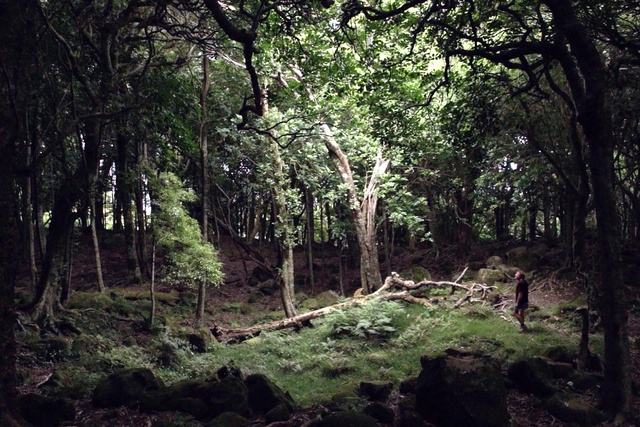
In nature, every single nook and cranny is used to build the local mosaic of life, from a giant tree right down to invisible insects and bacteria. In our numbing cities, there are acres of paved nothingness, across which people scuttle to get somewhere else. Fill them up with Life that will nourish not drain — creative life, human life, natural life.
Trees form communities, interlinked by trillions of fibres of mycorrhizal fungi through which they can communicate and share water/nutrients. They do this because a community is resilient. A lone tree is more vulnerable than a dense woodland. It is in the community’s interest that every component part is nurtured and assisted. If one tree dies and falls over, an open gap will allow wind and frost to cause further damage. Humanity’s fervent individualism is not found in nature.
So, let’s stop being egotistical colonialists and start thinking more like trees. Adaptability and variation are the strengths of Nature. Homogenisation is stasis and, ultimately, death through inability to adapt. Let’s think long and hard about the extent to which our minds have been colonised and try to overcome that… to become indigenised. Let’s relax the need for control and allow the result to be determined by the process/community. Let’s learn to think like a tree and design like nature. We might then have a chance of surviving the climate crisis.

